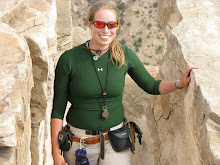MSU Geology Club visited Upheaval Dome during Spring Break last year (first week of March). It's interesting because it's one of the rare naturally-forming circular surface structures seen around the world, and debate has raged for years over what formed it. Two popular explanations prevail.
One hypothesis suggests that it is the remnants of and uplifting salt dome, eroded away presumably during the uplift of the Colorado Plateau, which the dome and surrounding Canyonlands are a part of.
Another hypothesis suggests the structure is an impact crater. Evidence for this (in my opinion) is particularly sparse. Obviously the shape and structure make it a prime candidate for impact crater consideration. Shocked quartz was recently found in the crater, though according to teh Wiki (noncited statement as far as I could tell), there may not have been more than a few grains found, and they were located off-center, which is interpreted by pro-impact types as evidence of an oblique impact. Shatter cones have also been found within the crater, which provide strong evidence for an impact. However, when the club was there, we spent an extensive amount of time debating the issue.
Points of Contention:
1. Uplift/deformation. The very definition of "dome." I don't know much about uplift of rock layers with impact structures in general, but it seems a bit too regular for an impact, especially an oblique impact as suggested by the impact proponents.
2. Lack of fracturing. Impact bodies general travel at speeds in the neighborhood of 10-15 km/s. To put it lightly, at that speed, an impact will not cause rock to bend - rock will fracture. Violently. Some upward "bending" might be possible on the impact rebound around the sides of the crater. Hard to say. I'm running impact models in my head, and as much as I like to pretend I'm a computer, I'm not. There would definitely be fragmentation, fracturing, and other forms of violent deformation on a large scale. Naked eye observation from a height doesn't really reveal that.
3. Shocked quartz (As opposed to normal quartz). Shocked quartz is formed only by high-impact events. In fact, the only types of events known to produce shocked quartz are asteroid/comet impacts and nuclear bomb detonations. I need to look up more reports about the volume of shocked quartz found at the site. Discovery News reported its discovery in Upheaval Dome right about the time the Geology Club spent our break on the Colorado Plateau and visited the Dome. The only source that gives a mention of the volume found is the Wiki article on Upheaval Dome, which claims that "only a few grains" of shocked quartz have been found. The Websites cited in that article are indeterminate with regard to volume of shocked quartz present. If there's significant shocked quartz, then sure, I'll go with the impact hypothesis. If not, we just can't know.
4. Shatter cones. These structures are often form beneath impact sites and radiate outward. They provide decent evidence for impact as well, but in some cases are tough to distinguish from slickensides.
Based on the current evidence, We have no effing clue what this circular structure is. I'm leaning toward salt dome for now. Read up on it and make your own decision.
Friday, January 9, 2009
Subscribe to:
Post Comments (Atom)

No comments:
Post a Comment